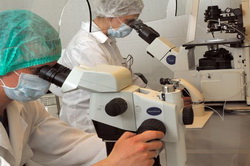When couples find it difficult to conceive naturally, they look for other options in order to have a baby of their own. Some choose adoption while others still strive to have their own blood flowing in the veins of their future baby. When conception seems hopeless for more than three years, couples have the option to choose artificial reproduction techniques, one of which is natural IVF.

General Facts about In Vitro Fertilization
IVF is the short term for in vitro fertilization. The treatment makes use of the egg cells and the sperm cells from the, although it depends where the infertility problem lies. IVF is one of the artificial reproductive programs offered by fertility doctors in order to have a successful conception. This technique is considered very expensive that others only resort to this as the last option if other less expensive fertility programs have failed.
The methods involved in IVF are the collection of mature eggs from the female patient and sample sperm cells from the male partner or donor. The eggs are manually combined with the sperm in the laboratory. The process is then carefully observed for hours and checked to see if any of the eggs have been fertilized. Once are fertilized, they are then grown in IVF incubators and observed for another two days. From the resulting embryos, the best or healthiest are chosen and transferred to the uterus of the woman which had been previously prepared to facilitate implantation and pregnancy.
Before the process of retrieving the eggs, the female patient is first given drugs to control the regular menstrual flow. The purpose for controlling the regular menstrual flow is for the female patient to produce more and healthier eggs. The more eggs are collected, the higher the chances of success.
Natural IVF cycle
Usually, IVF is done with medications in order to collect more eggs. With natural IVF, it does not involve controlling the menstrual flow in order to produce healthier eggs, which is in contrast to regular IVF. In a natural, regular menstrual cycle, there is only one domineering follicle which contains one egg or oocyte inside that develops. More monitoring processes are involved with this technique particularly with the use of blood tests and ultrasound in order to track the development of the follicle. Egg retrieval then follows in order to remove the egg from the follicle. When the retrieval is successful, fertilization process is done in the laboratory which is the same with the process done with the traditional in vitro fertilization. If a healthy embryo is produced, this is then transferred back to the patient's uterus.
Recently, natural IVF has been reintroduced as an alternative to traditional in vitro fertilization. The natural IVF technique was once practiced yet abandoned due to low success rates. Although natural IVF has lesser surgical risks and costs less compared to traditional IVF, there are a number of critical commentaries and studies published regarding this technique. Majority of experts in this field prefer to call this technique minimally effective rather than the minimal stimulation in vitro fertilization.
The benefits couples can get with natural IVF are the lower costs because there are lesser medications involved and there are no longer any risks with ovarian hyper stimulation syndrome.
